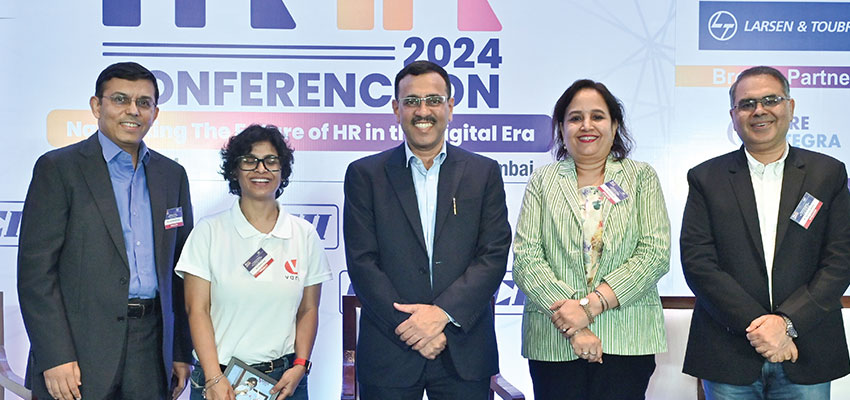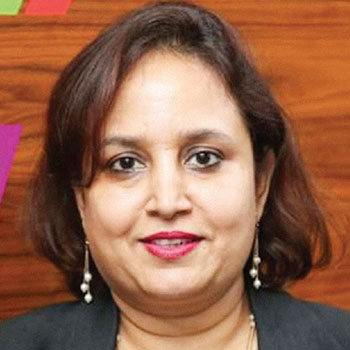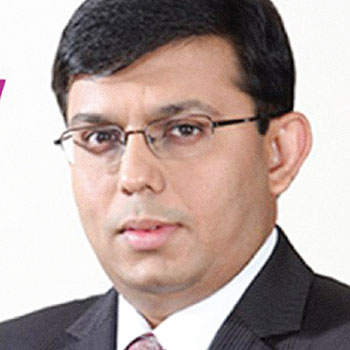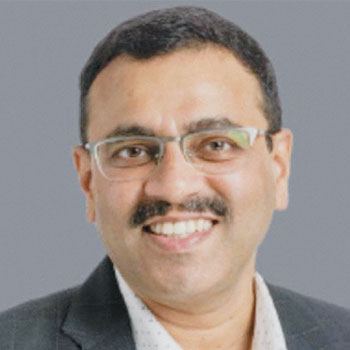Agile Leadership for Transforming Organisations

Agile leadership believes that individuals and teams are self-organising and capable of making good decisions when given autonomy and trust. Agile leaders serve as guides and mentors throughout the transformational journey. Confederation of Indian Industry (CII), Western Region recently held a conference in Mumbai themed ‘Navigating the future of HR in the digital era’ wherein esteemed panellists discussed on, Agile Leadership for Organisational Transformation. Corporate Citizen brings you excerpts of the session
-
Madhavi Lall, Managing Director, Head - HR, Deutsche Bank
-
Avijit Bhattacharya, CHRO, Tata Capital
-
Surender Mehta, CHRO, Nykaa
-
Rashmi Jha, Co-founder and CPO, Vani.coach
-
Anupam Sirbhaiya, CHRO and Administrative Officer, Bajaj Finance Ltd (Moderator)
Anupam Sirbhaiya: You (Madhavi Lall) said that you have seen a large transformation in the past 10 years. So what is it that makes a difference in an incremental transformation?
Madhavi Lall: Transformation is changing the fabric of an organisation. It is changing the business model completely. For example, companies had a brick and mortar structure and then came the e-commerce, that is transformation. So, how do you make sure that your business model is relevant to the new generation and the new consumers-that’s what transformation would be about. Change happens on a daily basis—change in your process, change in the way you talk to your customer or change in other things. Those are small incremental changes. Transformation is almost disruptive. Its fundamentally changing something about the business.
Q) You (Avijit Bhattacharya) have spoken a lot about agile leadership and action bias. You see that agile leadership is only about action bias. How do you see it from your perspective?
Avijit Bhattacharya: The way I would define agility is that it is not just speed but it is flexibility and speed. Fundamental changes in the organisation in the way it works, the way the mindset changes—this is in response to an external change whose speed today is very fast. So, it is not just action bias. Action or the execution leads to the change, but prior to that there are changes in the mindset, changes in culture, changes in processes. There are multiple changes which finally lead to an action that leads to the change. So it is not just the action. Action will finally make the change happen but it is much behind that which leads to a successful transformation.
"The spirit and energy makes you do beyond just the limit, and you are keeping yourself behind and are either to the larger purpose of the organisation or you are beyond your own purpose"
-Surender Mehta
Q) What’s the role leadership plays in sensing that the transformation is necessary? What is it that the leadership needs to do on a large scale?

Avijit Bhattacharya: The fact that one is a leader is essentially to understand what’s going to happen next. The fundamental function of a leader is to lead. Lead means taking someone or a set of people somewhere. A leader has to sense where to go and then energise the organisation to go there. So the first requirement in my view of a leader is to believe in that transformation and then energise the organisation or share that vision with the larger organisation to get to the good destination that the leader has decided. This has to have a reason and a purpose. In my view, three things define a leader and it has been true across all ages. One is the competence of the leader. The leader has to be seen as competent to lead the change. A leader has to have a character, which means that the change is for the greater good and not for the individual good of the leader, otherwise the leader will not have followers. Finally, the leader has to have the courage to lead. Without courage the change will never happen. It is likely the competence part, the ethos part, all of these are good in the character within the correct path. It is the competence part which needs a greater continuous learning and unlearning, so that one can lead in the new environment.
"Being agile as a leader has to be something across the organisation. It’s not that something HR is the sole bearer of it. It is just that HR is better placed to execute it and in brainstorming better ideas"
- Rashmi Jha
Q) What is the transformation role leadership can play, when there is disruption and resistance to change?

Surender Mehta:In my experience, leaders who are able to go beyond or emphasise on emotional arousal of the organisation over intellectual, are able to make that resistance easy. If you just keep it very mathematical or mechanistic, organisations can tend to be mechanistic many times. When you are more mechanistic, you don’t handle the change well. I think what the world of fast paced disruption and organisational transformation is lacking is spiritual maturity. It means, you first go inside, you look at the inside, for what strengths you have and what you don’t have. What change you need to make in your own self first, before you start judging the outside. And, then you look at attributes of more compassion of change—you become more compassionate and kind. One of the values we have in Nykaa is ‘Be bold and Be good’. We don’t want to bring disruptive change by being bold in the lifestyle or beauty industry. We want you also to be good.
Q) How do you (Rashmi Jha) see the difference in technology as a startup and as an effective business leader?
Rashmi Jha: When I joined the startup, there were already changes happening from the waterfall model to agile model because definitely the results we wanted to see were very different. You realise that by the time you make a product it’s no more usable. That was the very first beginning of being agile. So I learned the trade from there, back in 2010-12. That came very handy when we wanted to grow our Vani.coach. We realised that we need to transform. Earlier there was a centralised leadership, now that has to become more like a role based leadership. So, that was the first change and I was the one driving the change, because the mode of delivery changed. Earlier it was manual and now it has to be tech-based and product based, and I was leading the product. You actually don’t fit people into the room, you find skillsets you need to build towards the business role and then you train your people or you hire your people. It’s one of the ways we find that it is a simpler problem for us now. People don’t get bored because every time when you are building a product, you are aligned to it, you know that what it is going to be used for. That’s where I find the second transformation in my own company.
"The fundamental way in which agile leadership will work successfully is with communication and collaboration"
- Madhavi Lall
Q) Are all transformations today tech anchored? Are we only doing because of tech or are there more things playing across? Therefore, how we should play or think about these transformations?

Madhavi Lall: I think it is not all about tech. Tech is of course one of the disruptors of business. But it is also culture. It is also strategy of the organisation. Companies really never thought of ESG (environmental, social and governance). I know a lot of people think that ESG as a lip service but it’s not actually, because it is becoming more and more as a regulatory requirement as well. That is one area where we see a lot of transformations. Cultural transformations-if you have to look at your multi-generational workforcethe kind of culture you need to have in your organisation is very different from what you had five to ten years ago. You have got people who are 20+ coming into the workplace. You have somebody who is 60-year-old in the workplace, as retirement age is increasing due to growth in longevity and you have to earn for a longer period in order to be able to sustain yourself. I think those are the transformational changes people are seeing across organisations.
Q) How do you as leaders and HR function, will hold the multi-generation workforce through a large transformation?
Surender Mehta: It’s a rare incident—a couple of years ago, somebody came to me and shared an interesting problem with me. He said that a woman working as CXO in their organisation came to him and said that she cannot work with an uncle (older employee) and few days later that uncle came and said that he cannot work with these kids (young employees). Generational diversity is a real problem. I can draw insight from spirituality itself. Spirituality is not to look at people and deal with them in a place of hierarchy; you look at them for the value they bring and not from their designation, age and gender. You get respect because of the value you add to the table. I think, Indian scriptures speak of inclusion and respecting each others space, far more than what new age world has started to talk about.
The spirit and energy makes you do beyond just the limit, and you are keeping yourself behind and are either to the larger purpose of the organisation or you are beyond your own purpose. More you start to weave the goodness which is required to run the world into the organisation, the easier the game will become.

Avijit Bhattacharya: At any point in time an organisation will have multigenerational workforce. It is not that we have multigenerational workforce only today. Even in the 60s and 80s there were multigenerational workforce. The only difference is that in earlier decades, the generational gap in terms of aspirations, skills and worldview were more or less similar, the gaps were not too much. Today there is a huge variation. Therefore, it is important for both, the generation that is older and the newer one, to be able to understand the perspective of the other. Easy to say but very difficult to do. There has to be a mindset to unlearn, relearn and take new worldviews into consideration. The erstwhile command control era is out. The ability to decentralise or make people autonomous is in. Collaboration is extremely important to survive in the new world. These are the mindsets which have to be inculcated in the organisation to survive in the new world. Therefore, multigenerational workforce will always be a challenge in today’s world. HR has to enable them to develop the mindset to learn and unlearn, modernise training modules, give new exposures to different generations and help them work together. As it was mentioned earlier, about kids and uncles working together—they have to work together and HR has to facilitate them
Anupam Sirbhaiya: Before coming to Bajaj Finance, I worked for Centre for Creative Leadership, a research and development organisation and my colleague studied multi-generation workforce differences for two decades. I asked him, “What are the generational differences?” He said, “First and foremost point was that, in essence there is no difference.” I got shocked to be honest. He said that both of them say the same thing. The older person says, “I have experience, listen to me”. The younger person says, “I have perspective, listen to me”. We should respect each other’s views, which are coming from different eras or experiences in life, or the different ways they have been brought up. In older times, senior person said and junior person listened, that equation has changed even at home.
"The fundamental function of a leader is to lead. Lead means taking someone or a set of people somewhere. A leader has to sense where to go and then energise the organisation to go there"
-Avijit Bhattacharya

Rashmi Jha: I would like to share my first recruitment, a tech hire (recruit) from IIT Kharagpur. My co-founder is also from IIT Kharagpur. My entire team works from home.
The new recruit was half of my age. The first thing that I realised was that the lingo we used are so different. Everything that he wants to say is an abbreviation and I don’t like abbreviations—to an extent I am a communication coach. The first thing we have learnt is write clearly. So, that was the first thing I had to unlearn. If I have to get work done, I need to understand that POV stands for point of view and nothing else, and likewise there are so many. I had to break that barrier and had to ask him, “Please tell me what do you mean by that? Educate me.” That was the first thing where I stepped in. I had to learn where I had to tell him, “Look this is your perspective, we know that, we respect that but this is the business, this is something that you at least should be able to consider.” The multi-generation workforce difference is not something that never existed. It always existed. But right now, the barrier is more about how we deal with them—perspective matters to them a lot and that’s where we managed. We landed at the same page. It was something that both of us wanted to achieve. We had to just mend our ways.
Q) Transformation happening at a multigenerational workforce leads to culture change or business model change etc. What is the role of HR in enabling agile leadership in the company?
Madhavi Lall: The word agile is very daunting. People think they have to hop, skip and jump. Agile actually means doing things easily and quickly. In business context it means you are able to work solutions which are fast-which your customer can get at the right time, and the way the customer wants it. If we work backwards on that, what a leadership really needs to do, is to pursue what the customer wants and be able to articulate that with the larger organisation. The fundamental way in which agile leadership will work successfully is with communication and collaboration. It’s not like the old leadership style, where as a leader you said something and everybody ran around doing that. It is making sure that the communication is there. I think it’s an iterative process.
Q) When we think of transformation, are we thinking of taking the large organisation along? Historically we thought we keep strategy and the rest will follow. Have we moved away from that?

Avijit Bhattacharya: I work with the Tata Group that was started in 1868, 20 years before the Victoria Terminus (which is now Chhatrapati Shivaji Maharaj Terminus) was built in Mumbai. It is now we are where we are. After 156 years, the group has survived world wars, pandemics, independence subjugation and multiple political changes. It is still relevant, big and thriving. It has the highest market cap in the country today and it is global. What allowed it to survive and thrive? It’s basically its ability to transform at different points in time.
Transformation is essentially about anticipating change and executing that change. You will see most of the Tata companies are pioneers in the sectors that they are in. It means that they have the courage to get into uncharted territories. But that is not all. There has been a very large strong envelope of a value system which has remained unchanged for 156 years. It is this ability to transform on a constant value system that has helped the group to keep on transforming, remaining relevant and thrive. That defines transformation and agile leadership. This has happened through not one leader but multiple leaders who are agile, when they had long leadership.
Rashmi Jha: I am not from the HR fraternity, but being agile as a leader has to be something across the organisation. It’s not something that HR is the sole bearer. It is just that HR is better placed to execute it and in brainstorming better ideas. They are the ones who are nerves of the entire organisation. You understand from where the change should start. You start disrupting one thing at a time. It is not that you are going to disrupt the entire organisation at a time. First, it is not only HR who is the sole bearer of the change. Second is, one change at a time, that you can definitely transform.
"The power of culture in driving transformation is coming out uniform and driving across a multi-generation large transformation workforce "
-Anupam Sirbhaiya
Conclusion:

Anupam Sirbhaiya: The power of culture in driving transformation is coming out uniform and driving across a multi-generation large transformation workforce. I will speak about Satya Nadella and Microsoft. He made it real by making a very simple rally cry for transformation, for launching the company. Here was a successful company doing extremely well being in the top 10 market cap globally for decades. He says from 'know it all to learn it all'. The role of leadership while demonstrating multiple action is, rallying the troops in one single direction and building the culture. In a way he shifted the culture by saying, 'I am an expert, I am a specialist and everybody should listen to me.'He said, 'all of us can unlearn, all of us can relearn and that’s the only way to go forward'. One of the panellists also talked about that—the crux of any transformation from a leadership is also, as Madhavi said, "Communication is critical while taking large bets in rallying a large workforce, which could be dispersed across the globe or across generations". That’s something I would say is an important element of agile leadership that we may have to keep in mind as we drive organisation transformation.